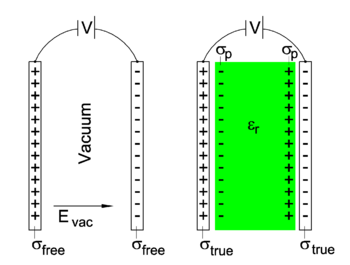Electric displacement
In physics, electric displacement, usually denoted by D, is a vector field in a non-conducting medium, a dielectric, that is proportional to the electric field E. In SI units,
where ε0 is the electric constant and εr is the relative permittivity. In Gaussian units ε0 is not defined and may put equal to unity. In vacuum the dimensionless quantity εr = 1 (both for SI and Gaussian units) and D is simply related, or equal, to E. Often D is termed an auxiliary field with the principal field being E. An alternative auxiliary field is the electric polarization P of the dielectric,
The vector field P describes the polarization (displacement of charges) occurring in a dielectric when it is inserted between the charged plates of a parallel-plate capacitor. Clearly, the fact that for any insulator εr > 1 (i.e., that D is not simply equal to εrE) has the same physical origin.
The electric displacement appears in one of the macroscopic Maxwell equations,
where the symbol ∇⋅ gives the divergence of D(r) and ρ(r) is the charge density at the point r.
Relation of D to surface charge density σ
The electric displacement D (is the magnitude of vector D, which points from − to + charge) is equal to the true surface charge density σtrue indicated in the figure, where two parallel-plate capacitors are shown that are completely identical except for the matter between the plates. In particular the plates have the same voltage difference V.
To explain this interpretation of D, we recall that the relative permittivity may be defined as the ratio of two capacitances, C ≡ Q / V, namely the ratio of the capacitance C of the capacitor filled with dielectric to the capacitance Cvac of a capacitor in vacuum,
where we used that Q is σ × A, with A the area of the plates.
Tensor character of D
As defined here, D and E are proportional, i.e., εr is a number (a scalar). For a non-isotropic dielectric εr may be a second rank tensor,
(To be continued)




![{\displaystyle \epsilon _{\mathrm {r} }\equiv {\frac {C}{C_{\mathrm {vac} }}}={\frac {Q_{\mathrm {true} }}{V}}\left[{\frac {Q_{\mathrm {free} }}{V}}\right]^{-1}={\frac {Q_{\mathrm {true} }}{Q_{\mathrm {free} }}}={\frac {\sigma _{\mathrm {true} }}{\sigma _{\mathrm {free} }}},}](https://wikimedia.org/api/rest_v1/media/math/render/svg/c05bbde9cced290ddf8f2450ae50a16ccf68065d)
